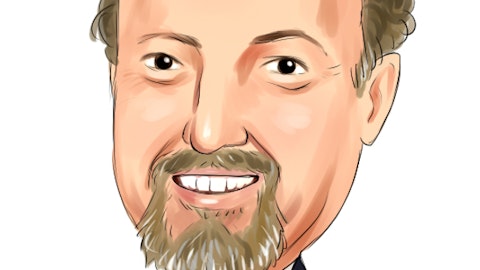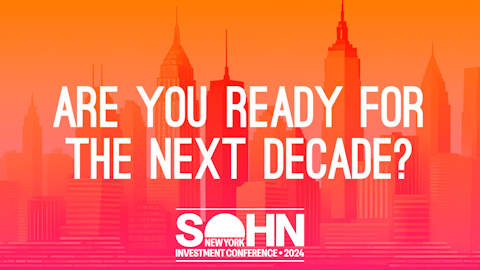Peter Wennink: And we are fully booked for 2024 and we are in the habit of actually shipping what we booked. So there’s little doubt in our mind that 2024 will just turn out the way that we gave you as an outlook.
Chris Caso: Understood. And as a follow-up is on memory. And you spoke last quarter and the very strong bookings last quarter were a lot of technology buys on memory. Could you give us some sense on when you expect some of the follow through from perhaps some of the DPV orders that would supply capacity for memory? We’ve seen some green shoots in the memory market. Just interested what your customers are telling you regarding that capacity.
Roger Dassen: Well, it’s very clear, as we mentioned before, that the utilization of memory is going up and we’ve seen that now quite sustainably for quite a while. And that — if that is sustained as we expect, as the market expects — as our customers expect, then you should see in the second-half of this year, you should see that memory is not just, let’s say, technology transition, but it’s also really the addition of bits. So that’s I think very much in line with the current developments that we see in the market. So in the second-half and one of the drivers why indeed you see this step up from the second-half to the first-half indeed is that you will see additional building of the capacity in the memory market.
Peter Wennink: Right.
Chris Caso: From a — and you’re saying that from a revenue standpoint in addition to an order standpoint?
Roger Dassen: I say that from the revenue standpoint. Exactly right, yes.
Chris Caso: From revenue standpoint.
Roger Dassen: Yes.
Chris Caso: Thank you.
Operator: Thank you. We will now go to the next question. And your next question comes from the line of Mehdi Hosseini from Susquehanna. Please go ahead.
Mehdi Hosseini: Yes, thanks for taking my question. But before, Peter, want to wish you best of luck in your next endeavor and hopefully running to you at some launch — at some April launch. And Christophe, hope to see you more often in US. Back to my question. Want to understand two things. First, what is the mix of backlog from attributed to China excluding EUV? And then second question, Roger, can you update us on the NXE:3800E? How is the throughput with the early system shipment in the first-half and how is it going to improve in the second-half?
Roger Dassen: Yes, so nice try, Mehdi, on China, but we’re not disclosing that. We’re not disclosing the composition of the backlog in a geographic sense. So we said before at some point that the China — we said at once that China was a little bit over 20% in the backlog and that as a result of that, no one should be surprised that the sales is around that percentage. That’s not dramatically changed. So I think we’re still in that ballpark, but we’re not going to be very specific on that. But at least that gives you a bit of a ballpark. As we said on the introduction of the 3800, we said before that this will come in full configuration in a couple of months’ time. So in the second-half, we’ll get it to 220 wafers per hour. Very quickly it’ll get to 195.
So it’s several steps. So first, very rapidly, getting it to 195 wafers per hour. And then the 2s that are going to leave the factory somewhere in the second-half or early in the second-half of this year will be 220 and the ones that are still at 195 will get an upgrade, such that I would say early in next year, you’ll see the entire fleet being at 220 wafers per hour. That’s the plan, Mehdi.
Mehdi Hosseini: To what extent that improvement towards 200 is a factor or driver in driving that EUR4 billion plus per quarter new orders?
Roger Dassen: In essence, it isn’t. This is a revenue recognition thing, right? So we’ll defer some of the revenue until the point in time where the ultimate configuration i.e., EUR220 is being achieved. So there is a revenue recognition issue here. It’s not a PO issue because the customer signed a PO or the tool at full spec.
Mehdi Hosseini: Got it. Thank you.
Roger Dassen: You’re welcome.
Skip Miller: All right, so I think we have time for one last question. If you’re unable to get through on this call and still have questions, please feel free to contact the ASML Investor Relations Department with your question. Now operator, may we have the last caller, please?
Operator: Thank you. We will now take the last question. And the question comes from the line of Didier Scemama from Bank of America. Please go ahead.
Didier Scemama: Hey, good afternoon. Thank you for squeezing me in. And warm congratulations, Peter. And if Martin is listening, thank you so much for everything really. It’s been an amazing privilege for me to cover the company for the last 24 years. And congratulations also to Christophe for the promotion to CEO job. I’ve got one question on EUV and DRAM, if I may. The question is really, first of all, can you tell us, roughly speaking, of your wafer capacity — of the wafer capacity deployed in the industry. How much has transitioned to EUV yet? And how much do you think that could evolve to, as the industry adopt EUV for DDR5 and HBM? And then related to that, I think in the past you had mentioned that over the longer term, I think 2030 was the sort of timeframe, the EUV unique breakdown could be 70-30 between logic and memory or DRAM.
Do you think that the layer count increase we see with HBM could drive that to maybe a 50-50 sort of split over the course of the next five or 10-years? Thank you so much.




